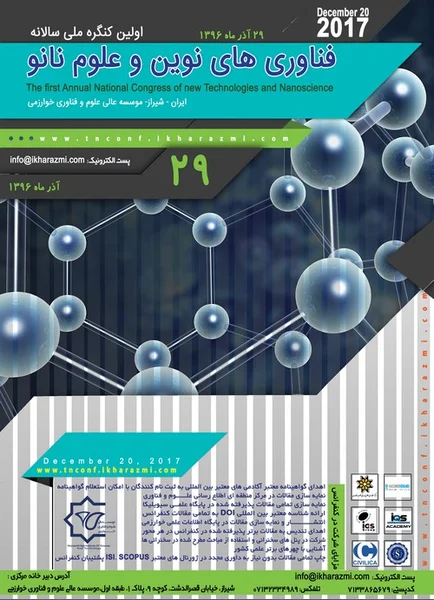-
effectively exerting the reinforcement and self-healing of polyvinyl alcohol hydrogel nanocomposite via physically functionalized graphene oxide for biomedical applications
جزئیات بیشتر مقاله- تاریخ ارائه: 1396/09/28
- تاریخ انتشار در تی پی بین: 1396/09/28
- تعداد بازدید: 549
- تعداد پرسش و پاسخ ها: 0
- شماره تماس دبیرخانه رویداد: -
hydrogels mimic native tissue micro- environment due to their porous and hydrated molecular structure [1][5]. an emerging approach to reinforce polymeric hydrogels with different nanoparticles and to include multiple functionalities focuses on incorporating nanoparticles within the hydrogel network to obtain superior properties and tailored functionality with emphasis on biomedical and pharmaceutical applications [10]. nano poly(dopamine)-treated graphene oxide/poly (vinyl alcohol) (“dg-o/pva”) nanocomposite hydrogels were made and characterized in this article via different tests including sem, mechanical and self-healing test, ftir and self-healing test. g-o was modified with nano poly(dopamine) in aqueous solution. a combination of hydrogen bonding, strong adhesion of nano poly(dopamine) at the interface of pva and g-o sheets, and reinforcement by g-o resulted in increase in self-healing and mechanical properties including tensile modulus, ultimate tensile strength, and strain-to-failure by 29, 80, and 69%, respectively, at 0.75wt% dg-o loading of the pva as a result of increased interfacial interactions between pva, poly(dopamine) and g-o along with significant self-healing that makes it suitable to be applied as a wound dressing and drug carrier to release different types of medicine in the next step of this research.
مقالات جدیدترین رویدادها
-
استفاده از تحلیل اهمیت-عملکرد در ارائه الگوی مدیریت خلاقیت سازمانی و ارائه راهکار جهت بهبود
-
بررسی تاثیر ارزش وجوه نقد مازاد بر ساختار سرمایه شرکت های پذیرفته شده در بورس اوراق بهادار تهران
-
بررسی تأثیر سطح افشای ریسک بر قرارداد بدهی شرکت های پذیرفته شده در بورس اوراق بهادار تهران
-
بررسی تأثیر رتبه بندی اعتباری مبتنی بر مدل امتیاز بازار نوظهور بر نقد شوندگی سهام با تأکید بر خصوصی سازی شرکت ها
-
تأثیر آمیخته بازاریابی پوشاک ایرانی بر تصویر ذهنی مشتری پوشاک ایرانی (هاکوپیان)
-
رهبری تحول آفرین عامل پیش برنده مدیران سازمان های آموزشی
-
تحلیل دینامیکی سد بتنی دو قوسی بختیاری با نرم افزار اباکوس
-
پرستاری بازتوانی بیمار محور برای افراد سالمند با مشکل دمانس
-
بررسی و مطالعه آزمایشگاهی میزان آب مورد نیاز مخلوط های بتن غلتکی روسازی (rccp)
-
industrial techniques which used to eliminate erosion corrosion in heat exchanger tubes
مقالات جدیدترین ژورنال ها
-
مدیریت و بررسی افسردگی دانش آموزان دختر مقطع متوسطه دوم در دروان کرونا در شهرستان دزفول
-
مدیریت و بررسی خرد سیاسی در اندیشه ی فردوسی در ادب ایران
-
واکاوی و مدیریت توصیفی قلمدان(جاکلیدی)ضریح در موزه آستان قدس رضوی
-
بررسی تاثیر خلاقیت، دانش و انگیزه کارکنان بر پیشنهادات نوآورانه کارکنان ( مورد مطالعه: هتل های 3 و 4 ستاره استان کرمان)
-
بررسی تاثیر کیفیت سیستم های اطلاعاتی بر تصمیم گیری موفق در شرکتهای تولیدی استان اصفهان (مورد مطالعه: مدیران شرکتهای تولیدی استان اصفهان)
-
طراحی، ساخت و کنترل ربات پرنده چهار ملخه کوچک برای طی مسیر خاص با استفاده از روش پرواز کور
-
مقایسه فرهنگ سازمانی و تعهد سازمانی در مدیران و معلمان دوره ابتدایی شهر قم
-
بررسی تاثیر انسان انگاری برند بر دفاع از برند با نقش میانجی عشق برند با نقش تعدیلگری نگرش نسبت به فاصله گذاری اجتماعی (مورد مطالعه: مشتریان محصولات سن ایچ)
-
بررسی تاثیر سطح سواد والدین بر یادگیری دانش اموزان ابتدایی شهر ایلام
-
کنترل پیش بینی مدل جهت مدیریت کارآمد منابع انرژی در ساختمان هوشمند




سوال خود را در مورد این مقاله مطرح نمایید :